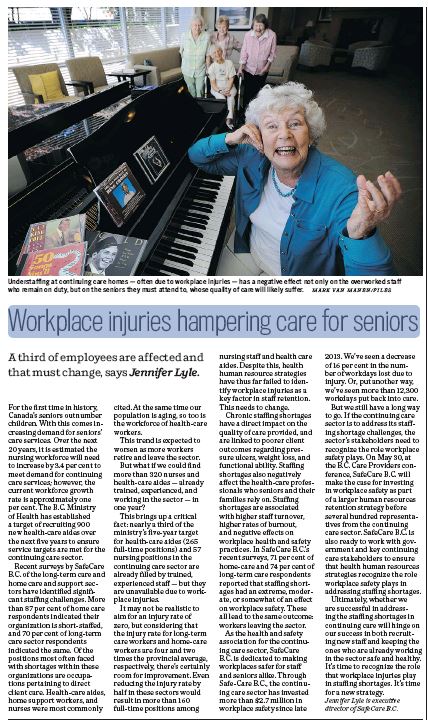The Vancouver Sun has published an opinion piece today from Jennifer Lyle, Executive Director for SafeCare BC regarding the important need to address staff shortages in B.C.’s continuing care sector. This is of particular importance considering the Minister of Health recently announced the hiring of 1,500 new staff over the next four years.
+++
The continuing care sector is facing a staffing crunch. For the first time in history, Canada’s seniors outnumber children. With this changing demographic comes increasing demand for seniors’ care services. Over the next twenty years, it is estimated that the Canadian nursing workforce will need to increase by 3.4% to meet demand for continuing care services; however, the current workforce growth rate is approximately 1%. The BC Ministry of Health has established a target of recruiting 900 new health care aides over the next five years to ensure service targets are met for the continuing care sector.
Addressing staffing challenges is a critical issue for the continuing care sector. Recent surveys by SafeCare BC of the long-term care and home care and support sectors have identified significant staffing challenges. Over 87% of home care respondents indicated that their organization is short-staffed, and 70% of long term care sector respondents indicated the same. Of the positions most often faced with shortages within these organizations are occupations pertaining to direct client care. Health care aides, home support workers, and nurses were most commonly cited. At the same time our population is aging, so too is the workforce of health care workers. This trend is expected to worsen as more workers reach the age of retirement and leave the sector.
But what if we could find over 320 nurses and health care aides—already trained, experienced, and working in the sector—in one year?

When talk of staffing shortages comes up, the instinct is to focus on recruiting more workers. But this misses a critical fact: nearly a third of the Ministry’s five-year target for health care aides (265 full-time positions) and 57 nursing positions in the continuing care sector are already filled by trained, experienced staff—but these staff are unavailable to work due to workplace injuries. To use a sports analogy, this would be like having to bench a third of your best players because of injury.
It may not be realistic to aim for an injury rate of zero, but considering that the injury rate for long term care workers and home care workers are four, and two-times, the provincial average, respectively, there’s certainly room for improvement. Even reducing the injury rate by half in these sectors would result in over 160 full time positions among nursing staff and health care aides.
Despite this, health human resource strategies have thus far failed to identify workplace injuries as a key factor in staff retention. This needs to change if we as a sector are to effectively address staffing shortages.

And for the sake of our seniors today, and for those in the future, it’s critical that we address staffing shortages. Chronic staffing shortages have a direct impact on the quality of care provided, and are linked to poorer client outcomes regarding pressure ulcers, weight loss, and functional ability.
Staffing shortages also negatively impact the health care professionals who seniors and their families rely on. Staffing shortages are associated with higher staff turnover, higher rates of staff burnout, and negative effects on workplace health and safety practices. In SafeCare BC’s recent surveys, 71% of home care and 74% of long term care respondents reported that staffing shortages had an extreme, moderate, or somewhat impact on workplace safety. These all lead to the same outcome: workers leaving the sector.
As the health and safety association for the continuing care sector, SafeCare BC is dedicated to making workplaces safer for staff and seniors alike. Through SafeCare BC, the continuing care sector has invested over $2.7 million in workplace safety since late 2013. We’ve seen a decrease of 16% in the number of workdays lost due to injury. Or, put another way—through education and awareness, we’ve seen over 12,300 workdays put back into continuing care.
But we still have a long way to go. If the continuing care sector is to address its staffing shortage challenges, the sector’s stakeholders need to recognize the role workplace safety plays. On May 30, at the upcoming BC Care Providers conference, SafeCare BC will make the case for investing in workplace safety as part of a larger human resources retention strategy before several hundred representatives from the continuing care sector as part of the conference’s Care to Debate event. SafeCare BC is also ready to work with government and key continuing care stakeholders to ensure that health human resources strategies recognize the role workplace safety plays in addressing staffing shortages.
Ultimately, whether we as a province are successful in addressing the staffing shortages in continuing care will hinge on our success in both recruiting new staff and keeping the ones who are already working in the sector safe and healthy. We need to stop benching our most valuable players because of workplace injuries. It’s time to recognize the role that workplace injuries play in staffing shortages. It’s time for a new strategy.
Jennifer Lyle
Executive Director, SafeCare BC




